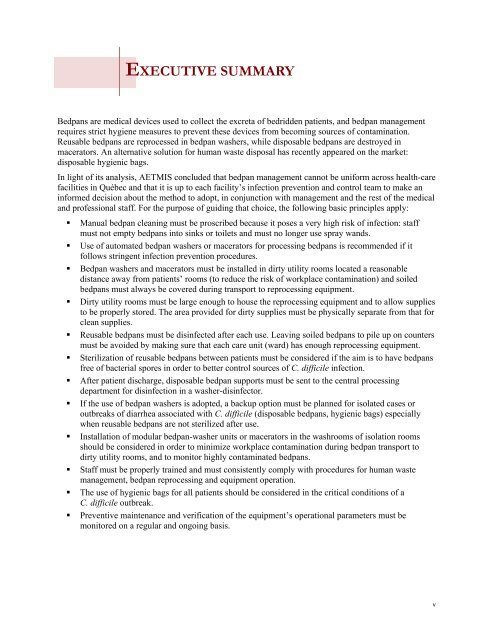Comparative Analysis of Bedpan Processing Equipment - Hygie
Comparative Analysis of Bedpan Processing Equipment - Hygie
Comparative Analysis of Bedpan Processing Equipment - Hygie
You also want an ePaper? Increase the reach of your titles
YUMPU automatically turns print PDFs into web optimized ePapers that Google loves.
EXECUTIVE SUMMARY<br />
<strong>Bedpan</strong>s are medical devices used to collect the excreta <strong>of</strong> bedridden patients, and bedpan management<br />
requires strict hygiene measures to prevent these devices from becoming sources <strong>of</strong> contamination.<br />
Reusable bedpans are reprocessed in bedpan washers, while disposable bedpans are destroyed in<br />
macerators. An alternative solution for human waste disposal has recently appeared on the market:<br />
disposable hygienic bags.<br />
In light <strong>of</strong> its analysis, AETMIS concluded that bedpan management cannot be uniform across health-care<br />
facilities in Québec and that it is up to each facility’s infection prevention and control team to make an<br />
informed decision about the method to adopt, in conjunction with management and the rest <strong>of</strong> the medical<br />
and pr<strong>of</strong>essional staff. For the purpose <strong>of</strong> guiding that choice, the following basic principles apply:<br />
Manual bedpan cleaning must be proscribed because it poses a very high risk <strong>of</strong> infection: staff<br />
must not empty bedpans into sinks or toilets and must no longer use spray wands.<br />
Use <strong>of</strong> automated bedpan washers or macerators for processing bedpans is recommended if it<br />
follows stringent infection prevention procedures.<br />
<strong>Bedpan</strong> washers and macerators must be installed in dirty utility rooms located a reasonable<br />
distance away from patients’ rooms (to reduce the risk <strong>of</strong> workplace contamination) and soiled<br />
bedpans must always be covered during transport to reprocessing equipment.<br />
Dirty utility rooms must be large enough to house the reprocessing equipment and to allow supplies<br />
to be properly stored. The area provided for dirty supplies must be physically separate from that for<br />
clean supplies.<br />
Reusable bedpans must be disinfected after each use. Leaving soiled bedpans to pile up on counters<br />
must be avoided by making sure that each care unit (ward) has enough reprocessing equipment.<br />
Sterilization <strong>of</strong> reusable bedpans between patients must be considered if the aim is to have bedpans<br />
free <strong>of</strong> bacterial spores in order to better control sources <strong>of</strong> C. difficile infection.<br />
After patient discharge, disposable bedpan supports must be sent to the central processing<br />
department for disinfection in a washer-disinfector.<br />
If the use <strong>of</strong> bedpan washers is adopted, a backup option must be planned for isolated cases or<br />
outbreaks <strong>of</strong> diarrhea associated with C. difficile (disposable bedpans, hygienic bags) especially<br />
when reusable bedpans are not sterilized after use.<br />
Installation <strong>of</strong> modular bedpan-washer units or macerators in the washrooms <strong>of</strong> isolation rooms<br />
should be considered in order to minimize workplace contamination during bedpan transport to<br />
dirty utility rooms, and to monitor highly contaminated bedpans.<br />
Staff must be properly trained and must consistently comply with procedures for human waste<br />
management, bedpan reprocessing and equipment operation.<br />
The use <strong>of</strong> hygienic bags for all patients should be considered in the critical conditions <strong>of</strong> a<br />
C. difficile outbreak.<br />
Preventive maintenance and verification <strong>of</strong> the equipment’s operational parameters must be<br />
monitored on a regular and ongoing basis.<br />
v


